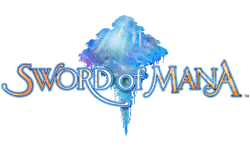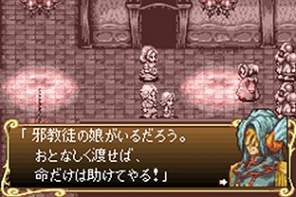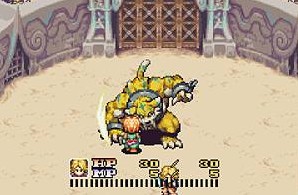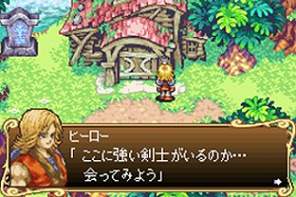|
|

|
PLATFORM
|
GBA
|
BATTLE SYSTEM
|

|
INTERACTION
|

|
ORIGINALITY
|

|
STORY
|

|
MUSIC & SOUND
|

|
VISUALS
|

|
CHALLENGE
|
Very Easy
|
COMPLETION TIME
|
Less than 20 Hours
|
|
OVERALL

|
+ Whole different experience than original.
+ Beautiful art direction.
- Brain-dead A.I. and useless magic.
- Sluggish, clunky menus.
- Campy story.
- Weak musical quality.
|
Click here for scoring definitions
|
|
|
After Secret of Mana, the Seiken Densetsu (or just Mana) series went into something of a slump, with Legend of Mana in particular evoking mixed reaction from the gaming world, receiving praise for its gorgeous music and graphics but damnation for its simplistic gameplay and story. Afterward, Square, which had since then become Square-Enix, tried to bring the franchise back to its roots with a remake of the first Seiken title (originally released as Final Fantasy Adventure in North America) called Shinyaku Seiken Densetsu, localized to North America as Sword of Mana. The remake integrates elements from Secret of Mana that made that particular title fun, but still falls short of the original version.
Long ago, there was a goddess who decided to transform herself into a Mana Tree to watch over the world. One day, a man named Vandole used the power of Mana to build a great civilization, making the world bow before his will. Just about when all hope was lost, several brave youths, one with a holy blade, vanquished Vandole and restored the power of Mana to its proper place. However, time passed, and just as most have forgotten about Mana again, a prince named Stroud decides to don a party mask, have everyone call him Dark Lord, and hunt down members of the Mana Clan as heretics. Consul Hermann is believed to be harboring said clansmen, including a young girl who escapes with Hermann's son, and while she gets away, the boy is captured and forced to fight as a gladiator, until one day escaping and wishing to avenge his parents.
New to the remake is the ability to play as either the hero (Hermann's son) or heroine (the Mana Clanswoman), with both having different storylines that interconnect at times. Either gets a vast arsenal of weapons with which to hack away at enemies populating fields and dungeons between or outside towns, with the choice of either character mainly affecting which weapon they won't be able to use: the staff (in the hero's case) or the sword (in the heroine's case). Enemies fought in real-time have various weaknesses and immunities to the different kinds of weapons, with Popoi's Notebook luckily keeping track of their strengths/weaknesses. Experimenting with the different types of weapons has its benefits, as doing so gradually raises their levels, increasing their damage and the rate in which they increase the protagonist's deathblow gauge, allowing him/her to perform a powerful attack and depleting afterward.
 "Hey, I'm Dark Lord, I like to wear a party mask and hunt the Mana Clan as heretics! Now gimme some candeh!"
"Hey, I'm Dark Lord, I like to wear a party mask and hunt the Mana Clan as heretics! Now gimme some candeh!"
|
|
Magic returns, as well, with the Mana franchise's eight elemental spirits acquirable during the game. However, unlike in Secret of Mana or Seiken Densetsu 3, magic use occurs in real-time; the player first needs to equip one of the elemental spirits and hold down the R button to bring it into view. Every spirit has one support spell and one attack spell, with both naturally consuming MP. If the player releases the R button immediately after holding it down, the spirit's support spell executes, but if the player releases it after the spirit is actually visible, its attack spell will execute, with its range depending upon the protagonist's current weapon. As with weapons, spirits have levels that gradually rise after repeated use, although since there are only a select few enemies vulnerable only to magic, players will more rely upon weapons.
The protagonist can also jump with the L button or squat when the player holds down the L and A buttons, in which case he/she will slowly recover MP, although doing so is typically risky in the heat of battle. Allies now have HP/MP and weapon/magic levels unlike in the original, and while the player can adjust their A.I. setting in the menus, allies tend to be about as reliable as FDR's legs, and easily get killed, never dashing and keeping up poorly with the protagonist. Another new feature is the Hot House, where the player can upgrade weapons and armor with various materials and plant seeds to grow fruits and vegetables to temper equipment.
Upgrading and tempering weapons can literally be the difference between victory and defeat, especially if the player focuses on weapons that can potentially hit enemies more than once, such as the bow and arrow. As such, boss fights, as long as the player exploits their weaknesses, can typically be quick affairs, much like in the original. All in all, the battle system does have its moments, with the fun of building weapons like in Secret of Mana being a strong point, although the general awkwardness of the magic system, not to mention the brain-dead ally A.I., and slight lag during normal attacks (which can make it difficult to string together attack combos, if available for a weapon), will make many players yearn for the simplicity of the original game.
 The first fight
The first fight
|
|
Interaction doesn't fare any better, with the clunky ring menu system frequently haunting the player throughout the game. Item use requires the player to brave several sluggish menus, with some genius at Brownie Brown thinking it would be cute, as well, to divide items into several different submenus and thus compound the tedium of menu navigation. Changing weapons and spirits requires players to navigate a few menus, as well, which can somewhat burden combat. The spacing of save points is also a bit poor at times, and while Popoi's Notebook is handy in tracking enemy strengths and weaknesses, the interface could have been much better overall.
Since Sword of Mana generally feels different than the original, it definitely deserves points for creativity, despite integrating elements from Secret of Mana like weapon and magic levels, along with superficial series elements like rabites, dancing merchants, and even elements from Legend of Mana like Niccolo the fat cat-rabbit salesman.
One thing changed for the worse, however, is the story, with many plot aspects rewritten for the remake, in spite of some additional depth and longer conversations absent in the original. Deeper, however, doesn't mean better, with the translation also seeming to bear a bit of censorship, what with lines such as "Blast it...! BLAAAAAAAAAAST IT!!!" which no Anglophone would ever say, unless on drugs. The plot further emphasizes the trite theme of the power of love and friendship, with most villains ending up canonized somehow, as well, along with some holes such as the lack of explanation of how Dark Lord rises to power. All in all, given the general campy nature of the story, it will make many yearn for the simplicity of the original's plot.
 Checking the mail
Checking the mail
|
|
As with most Gameboy Advance titles, unfortunately, the music quality leaves something to desire, with Kenji Ito's remixed soundtrack sometimes often sounding as it did in the original version, with blips, duts, and chukkas galore. The tracks are okay, as are the sound effects, although the developers could have definitely bettered this aspect.
The visuals are probably the strongest part of the game, with most sprites seeming to come from Seiken Densetsu 3 and scenery coming from Legend of Mana, a fusion that works, with vibrant hues and environments. Every character has a portrait, as well, even if many males appear somewhat androgynous. Still, aside from some occasional slowdown when many monster sprites are on the screen, the graphics are the remake's best aspect.
Finally, the remake is a few hours longer than the original, yet short nonetheless, taking less than twenty hours to complete, with little, aside from some optional NPC requests (which may require a guide), to boost playing time. Overall, Sword of Mana does have its strong points, such as nice art direction and feeling like a different experience than Final Fantasy Adventure, although this new feel isn't always a good thing, given the issues with combat, the interface, the plot, and music quality. It is more enjoyable than Legend of Mana, but nonetheless continues the Seiken franchise's curse of perpetual mediocrity.
Review Archives
|









